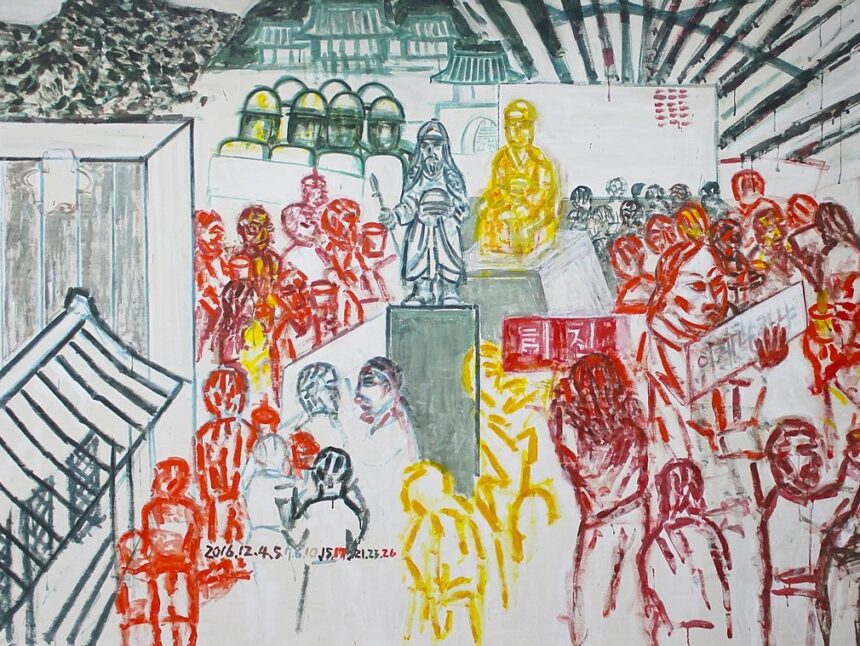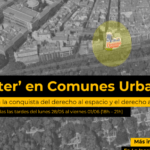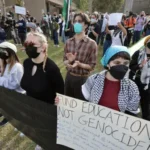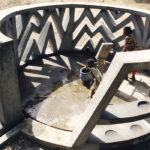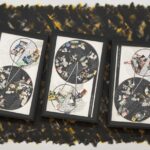The Art of Protest
Heng-Gil Han
This report describes a protest that took place nationwide in major cities across South Korea every Saturday for twenty consecutive weeks from October 29, 2016 to March 11, 2017. The rallies on the Gwanghwamun Plaza in Seoul, the hub of the protest, particularly involved a diverse range of artistic actions manifesting political demands in satires and parodies, making the protest remarkably convivial and festive. The arts’ involvement defied commonly held ideas about protests in Korea, which conjure up images of violence and riots. The example set by this protest, which successfully brought about significant political and social changes in Korea, may be especially relevant to those who are community or protest organizers and those who make socially and/or politically engaged art. The conviviality found in the protest can inspire activists and artists around the world who are fighting for democracy and justice, and against corruption and inequality.

The Protest
The protest was called the Candlelight Vigil, which refers to the now iconic candles displayed by participants at the night time demonstrations. It was also called the Candlelight Struggle to stress its arduous nature, or the Candlelight Revolution to point out the triumphal outcome of overthrowing the national leader, Park Geun-Hye,in a relatively short time.
The rallies were initially organized by the Headquarters of the Struggle of All People’s Rise, a solidarity coalition of fifty-three entities led by the Korean Confederation of Trade Unions.[1] Soon after the second rally, the People’s Emergency Action for Park’s Resignation, a voluntary coalition with no central leadership figure or group, was formed on November 9, 2016, to bolster the rallies.[2] Over the course of the protest, more than fifteen hundred civic organizations joined the coalition, and according to the organizer, the total accumulated number of participants in all rallies reached more than sixteen million citizens.[3] Park increasingly became recalcitrant and the protest progressively became bigger and stronger in response. As a result of Park’s confrontational attitude towards the demonstrations, the main objective of the campaign eventually shifted from seeking Park’s resignation to her impeachment.
A combination of many factors fed the sense of public outrage. One of the major factors was the Sewol Ferry Disaster. On April 16, 2014, the Sewol Ferry sank in the Southwest Sea of Korea, incurring 304 casualties, including 250 students and teachers from Danwon High-school in Ansan, who were on an annual school-trip. The most disturbing part of the disaster was that the captain and 14 crew members fled the sinking ship while telling the passengers to stay in their cabins. The innocent adolescentswaited for evacuation orders which never came.[4] Koreans became skeptical about Park’s ability to manage such emergencies and crises.
The public antipathy toward Park worsened on account of Choi Soon-sil Gate, a political scandal that broke out on September 20, 2016. Park clandestinely shared state secrets with personal friend Choi Soon-sil, who held no official position or security clearance, who consulted with her about national policies. By using her relationship with the president, Choi extorted a total of 60 million USD from family-owned industrial conglomerates, such as Samsung, Hyundai, and LG, in the form of donations to the charity organizations, Mir Foundation and K-Sports Foundation, from which she subsequently embezzled the money.
In people’s mind, Park was irredeemably condemned when the Blacklist of Artists scandal broke on October 12, 2016, which motivated a number of artists to join the protest against Park. More than 10,000 professionals in the cultural sector were covertly banned from receiving state funding for being publicly critical of Park and/or supporting rival political parties. The exposed cultural blacklist was dated May 2015, when small scale, ongoing protests were criticizing the administration’s mishandling of many issues, including those related to the Sewol Ferry Disaster.[5]
There were many additional issues that led to the protest. The nationwide demonstration successfully achieved its goal of removing Park, who was impeached in March 2017 and is currently serving a twenty-four year sentence for sixteen separate crimes including corruption, coercion and abuse of power, leaking classified information, maintaining the blacklist of artists, etc.[6] In sum, the protest represented a resistance to our viciously cynical system of capitalism that deepens inequality by only serving the wealthy, powerful and connected. How did art contribute to the successful disruption of a system that structurally widens the gap between the privileged few and the majority?
The Art
In early November 2016, I passed through Gwanghwamun Plaza, witnessing one of the rallies by chance. The sun was setting, the plaza was not fully packed yet, and people were strolling. I saw a large stage constructed at the front of the plaza. Not understanding that this was in fact a protest, I thought at first they were setting up for a rock concert. The atmosphere of the place was not what I would have expected of a protest in Korea.
I soon realized that a demonstration was about to begin. Some young adults were standing here and there, giving out flyers, signs with slogans, and yellow ribbons commemorating the Sewol Ferry Disaster. Blackboards were installed, where people wrote messages or drew images. Post-it notes were available for anyone to write a short message and stick it on the police vehicles that were parked back-to-back to form a wall to contain the crowds within the plaza. The stage was for musicians and comedians to perform, which made the protest fun. Popular singers appeared and sang protest songs. Prominent actors performed witty, satirical scenes. The stage was also for any individuals to exercise their right to free speech, sharing their opinions and feelings about relevant issues, corruption and social injustices. The audience was shouting, applauding, laughing, singing and chanting in response to the performers or speakers.
Artists were making impromptu artworks here and there. Some were drawing images and writing calligraphy on canvas fabric or large sheets of paper rolled out on the ground. Tall caricature statues were erected, and works of installation art were mounted. Some people were wearing masks to poke fun at Park’s request for an anti-mask law to ban the protesters from concealing their faces. The masks made the protest more cheery and festive as they were reminiscent of Mardi Gras in New Orleans.[7] A number of photographers and videographers were documenting the protest scenes. They individually made artistic videos and shared them through youtube and vimeo.[8]
Blacklist artists erected a row of tents where they stayed through the winter months of the demonstration.[9] They also installed the Field Museum of Poor Political Contemporary Art (MPPCA), critically parodying the National Museum of Modern and Contemporary Art (MMCA) of Korea, which failed to offer a critical voice by refraining from commenting on or participating in the protest. Musicians played concerts and actorsperformed outdoor theater. Temporary galleries were installed, presenting photographs of the Sewol Ferry Tragedy. Poignantly, a tent that housed a mourning altar commemorating the children who died in the Sewol Ferry was also erected. People took off their shoes, entered the tent, and bowed three times toward the altar out of respect for the dead, which is customary in Korea.
The Protest as Art
The massive protest unfolded as “a nonviolent, public forum”[10] which tookthe form of a convivial festival.[11] Teargas, rocks, and molotov cocktails, which I remember from my own experience of and participation in protests in the 1980s, were replaced with artistic activities, including singing, dancing, performances, exhibitions, and making art on the site.[12] The protest was packed full with humor, wit and parody.[13] Art served to draw public attention: it encouraged people of all ages join the protest, and it built empathy and collective unity.
Protesters were not just observers of art. They actually made art. The protest provided an environment for the participants to express themselves through artistic actions. Their emotional thoughts were unleashed as they were – raw, organic, and natural – without being formally refined, manifesting the spirit of freedom that doesn’t have a particular form in which to appear. All forms of arts – traditional, modern, folk or craft, and high arts – were freely reinvented and remixed to address the critical conditions of Korean politics and society.
Gwanghwamun Plaza is a symbolic place representing the highest power of Korean society. That place has been reborn as a place for common citizens and the center for resistance to power. The art actions in that newly emerged common space seem to introduce a new aesthetic framework which artists should study closely to advance contemporary art thataffects a more tangible and participatory engagement with issues of social justice. Looking back on the protest, I am reminded of the success of the AIDS Memorial Quilt (1987), which took the form of a massive outdoor exhibition to raise awareness about the disease. Can the effectiveness with which the Candlelight Vigil mobilized its various constituent artistic forms not be considered a success in the same way?
Heng-Gil Han, the Co-Founder and Director of Korea Art Forum, has curated an innovative series of international exhibitions and conferences exploring North Korean art with the goal of advancing contemporary art and supporting global peace-building endeavors. Previously, Han served as a curator for the 2008 Busan Sculpture Project, Busan Biennale, and the 2009 and 2011 Incheon Women Artists’ Biennales, all in South Korea. From 2002 to 2012, Han served as the Visual Arts Director and Curator for the Jamaica Center for Arts & Learning (JCAL) in Queens, NY. At JCAL, Han conceived and implemented Jamaica Flux: Workspaces & Windows, a large-scale project of site-specific and social practice art that supported emerging artists as well as the local community by connecting arts and commerce. Han received a Research Fellowship from the Asian Cultural Council in 2017; a Curatorial Fellowship from the Andy Warhol Foundation for the Visual Arts in 2015; a Project Development Grant from the Arts Council Korea in 2012; and a Cyber Residency Scholarship from the Bronx Council on the Arts in 2001. A collection of his critical essays on contemporary art, Network and Fluid, was published by the Stone & Water Art Project (SAP) in South Korea in 2009.
Endnotes
[1]“Movement for Removal of Park Geun-Hye [President Toejin Undong].” Korean Wikipedia. accessed on May 30, 2018.
[2] Sun-Chul Kim, “South Korea’s Candlelight Protest,” East Asia Forum, Feb 7, 2017. accessed June 3, 2018,
[3]Alexis Dudden, “Revolution by Candlelight: How South Koreans Toppled a Government,” Dissent, Fall 2017. accessed June 2, 2018.
[4] Daniel Peters. “The classroom frozen in time: Eerie pictures of student desks untouched since they drowned in South Korean ferry disaster two years ago.” Daily Mail. May 24, 2016. accessed on May 30.
[5] Sun-Chul Kim. Ibid.
[6] Benjamin Hass, “South Korea: former president Park Geun-hye sentenced to 24 years in jail.” The Guardian, April 6, 2018. accessed on June 3, 2018.
[7] Alexis Dudden also makes a similar comparison in her essay. Ibid.
[8] An example of one such video can be seen at vimeo.com/192096210.
[9] Jong Hwan Park, “Artists on the Plaza for 127 Days [Gwangjangui Yaesulgadeul, 127 Ganui Girok]” News 1, 2017. 03. 01. accessed on June 1, 2018.
[10] Alexis Dudden. Ibid.
[11]David Volodzko reports. “South Korea’s Million-Strong March.” The Diplomat. Nov 19, 2016. accessed June 2. 2018.
[12] Sun-Chul Kim.Ibid.
[13] Se-jong Kim reports. “Peace, parody replace violence at protests,” Korea Times, Nov 27, 2016. accessed on June 3, 208.

